Capital Structure Analysis of Woodside Ltd - Corporate Finance
VerifiedAdded on 2023/06/03
|15
|4437
|323
Case Study
AI Summary
This case study provides a comprehensive capital structure analysis of Woodside Petroleum Limited, an Australian petroleum company, comparing it with BHP Billiton and Santos from the same industry. It examines the company's financing and leverage history, current leverage policies, and interes...
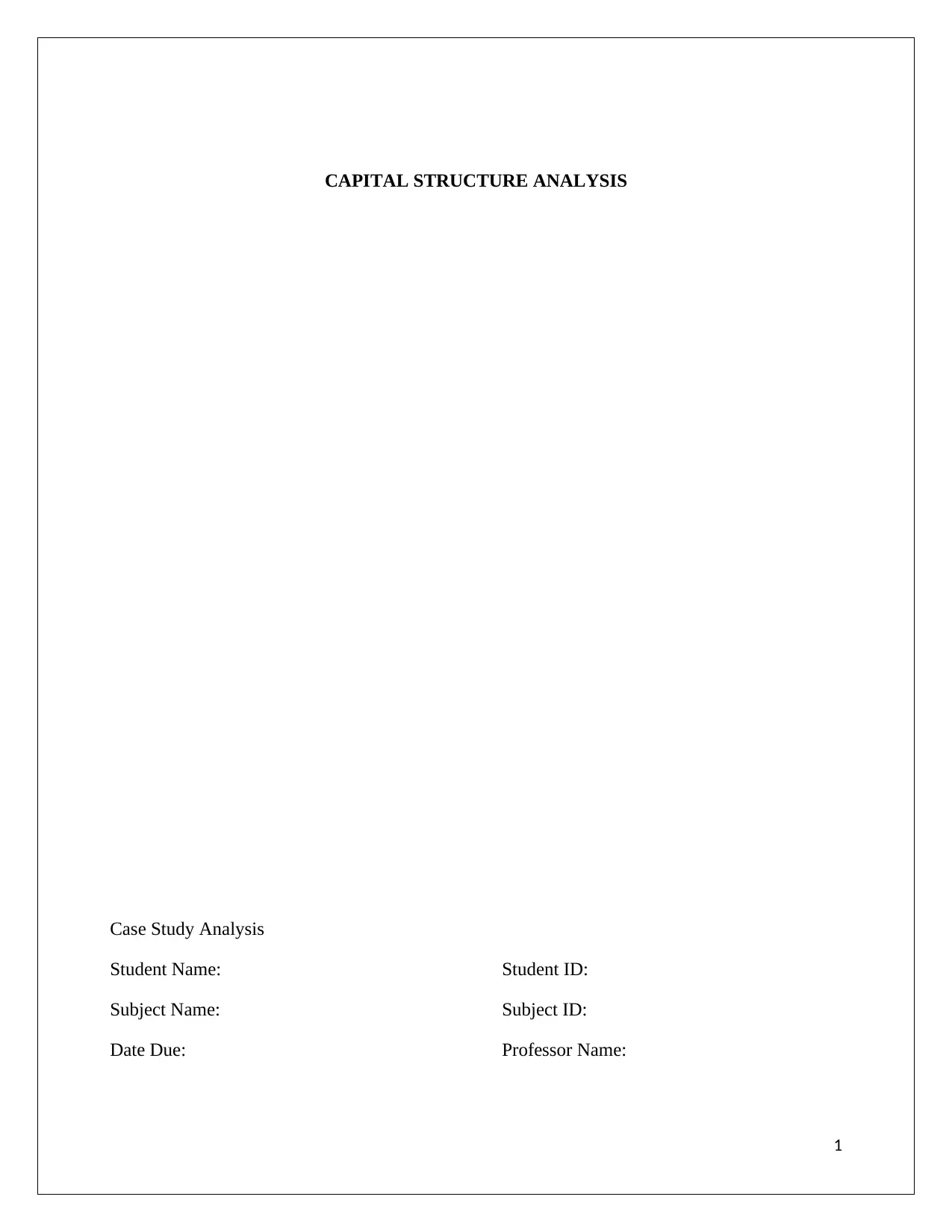
CAPITAL STRUCTURE ANALYSIS
Case Study Analysis
Student Name: Student ID:
Subject Name: Subject ID:
Date Due: Professor Name:
1
Case Study Analysis
Student Name: Student ID:
Subject Name: Subject ID:
Date Due: Professor Name:
1
Paraphrase This Document
Need a fresh take? Get an instant paraphrase of this document with our AI Paraphraser
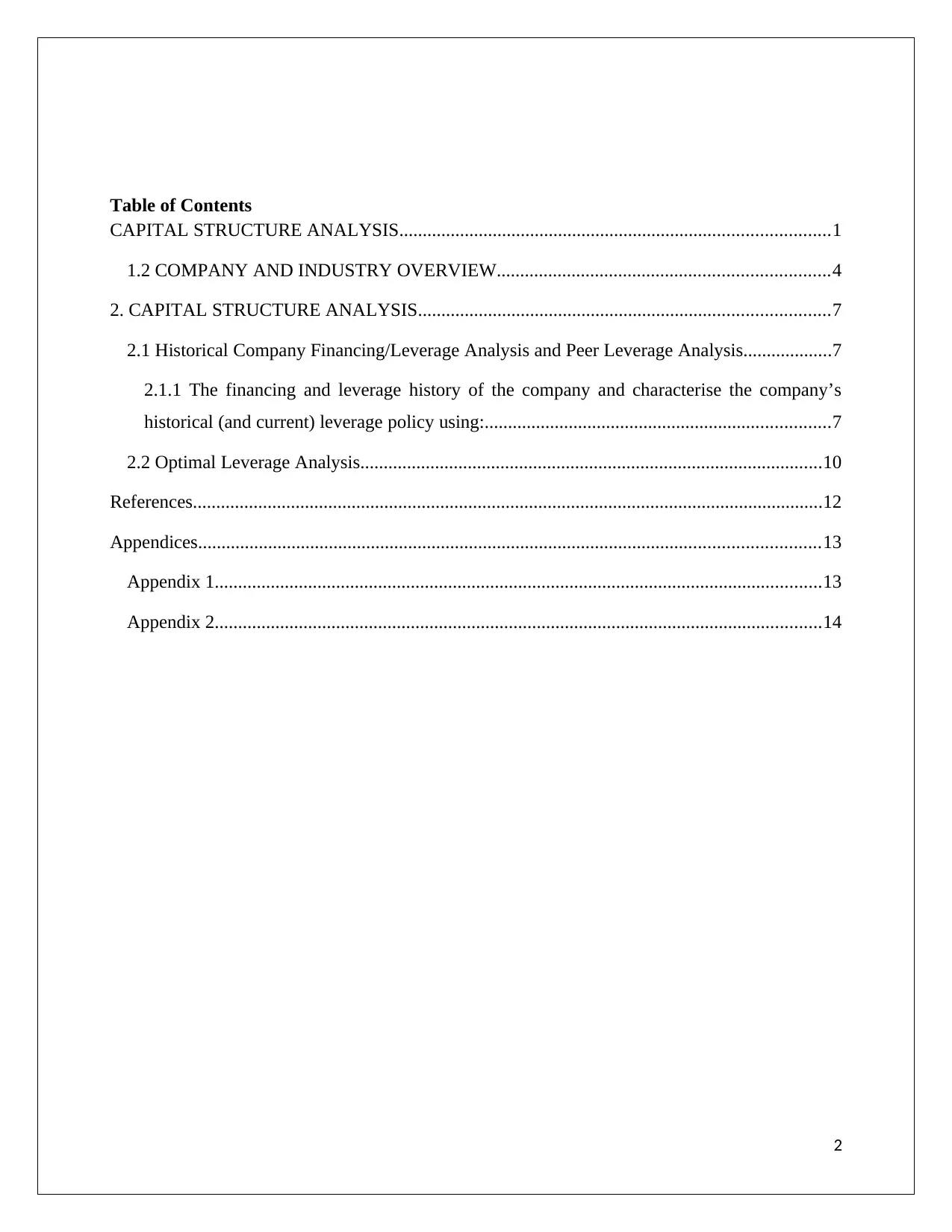
Table of Contents
CAPITAL STRUCTURE ANALYSIS............................................................................................1
1.2 COMPANY AND INDUSTRY OVERVIEW.......................................................................4
2. CAPITAL STRUCTURE ANALYSIS........................................................................................7
2.1 Historical Company Financing/Leverage Analysis and Peer Leverage Analysis...................7
2.1.1 The financing and leverage history of the company and characterise the company’s
historical (and current) leverage policy using:..........................................................................7
2.2 Optimal Leverage Analysis...................................................................................................10
References.......................................................................................................................................12
Appendices.....................................................................................................................................13
Appendix 1..................................................................................................................................13
Appendix 2..................................................................................................................................14
2
CAPITAL STRUCTURE ANALYSIS............................................................................................1
1.2 COMPANY AND INDUSTRY OVERVIEW.......................................................................4
2. CAPITAL STRUCTURE ANALYSIS........................................................................................7
2.1 Historical Company Financing/Leverage Analysis and Peer Leverage Analysis...................7
2.1.1 The financing and leverage history of the company and characterise the company’s
historical (and current) leverage policy using:..........................................................................7
2.2 Optimal Leverage Analysis...................................................................................................10
References.......................................................................................................................................12
Appendices.....................................................................................................................................13
Appendix 1..................................................................................................................................13
Appendix 2..................................................................................................................................14
2
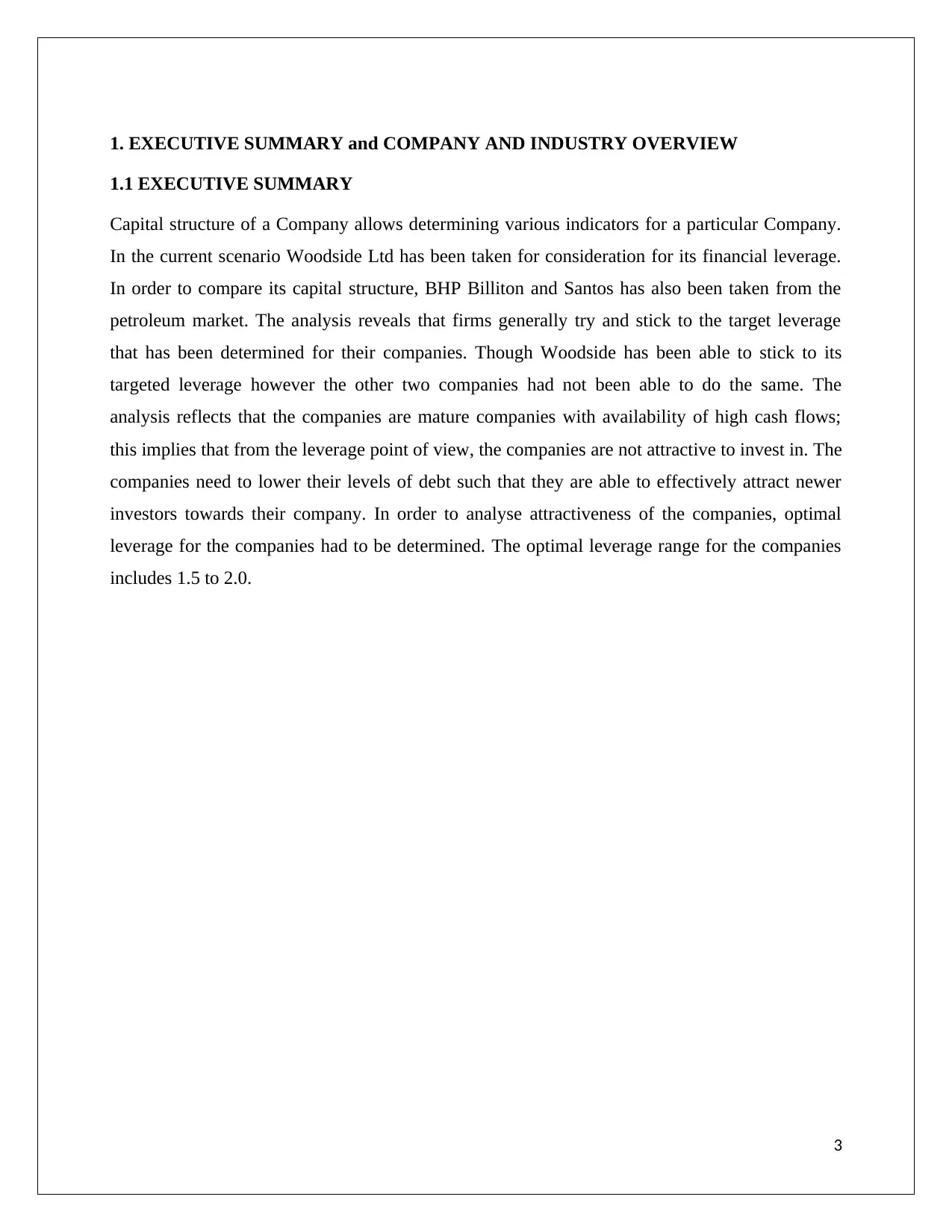
1. EXECUTIVE SUMMARY and COMPANY AND INDUSTRY OVERVIEW
1.1 EXECUTIVE SUMMARY
Capital structure of a Company allows determining various indicators for a particular Company.
In the current scenario Woodside Ltd has been taken for consideration for its financial leverage.
In order to compare its capital structure, BHP Billiton and Santos has also been taken from the
petroleum market. The analysis reveals that firms generally try and stick to the target leverage
that has been determined for their companies. Though Woodside has been able to stick to its
targeted leverage however the other two companies had not been able to do the same. The
analysis reflects that the companies are mature companies with availability of high cash flows;
this implies that from the leverage point of view, the companies are not attractive to invest in. The
companies need to lower their levels of debt such that they are able to effectively attract newer
investors towards their company. In order to analyse attractiveness of the companies, optimal
leverage for the companies had to be determined. The optimal leverage range for the companies
includes 1.5 to 2.0.
3
1.1 EXECUTIVE SUMMARY
Capital structure of a Company allows determining various indicators for a particular Company.
In the current scenario Woodside Ltd has been taken for consideration for its financial leverage.
In order to compare its capital structure, BHP Billiton and Santos has also been taken from the
petroleum market. The analysis reveals that firms generally try and stick to the target leverage
that has been determined for their companies. Though Woodside has been able to stick to its
targeted leverage however the other two companies had not been able to do the same. The
analysis reflects that the companies are mature companies with availability of high cash flows;
this implies that from the leverage point of view, the companies are not attractive to invest in. The
companies need to lower their levels of debt such that they are able to effectively attract newer
investors towards their company. In order to analyse attractiveness of the companies, optimal
leverage for the companies had to be determined. The optimal leverage range for the companies
includes 1.5 to 2.0.
3
You're viewing a preview
Unlock full access by subscribing today!
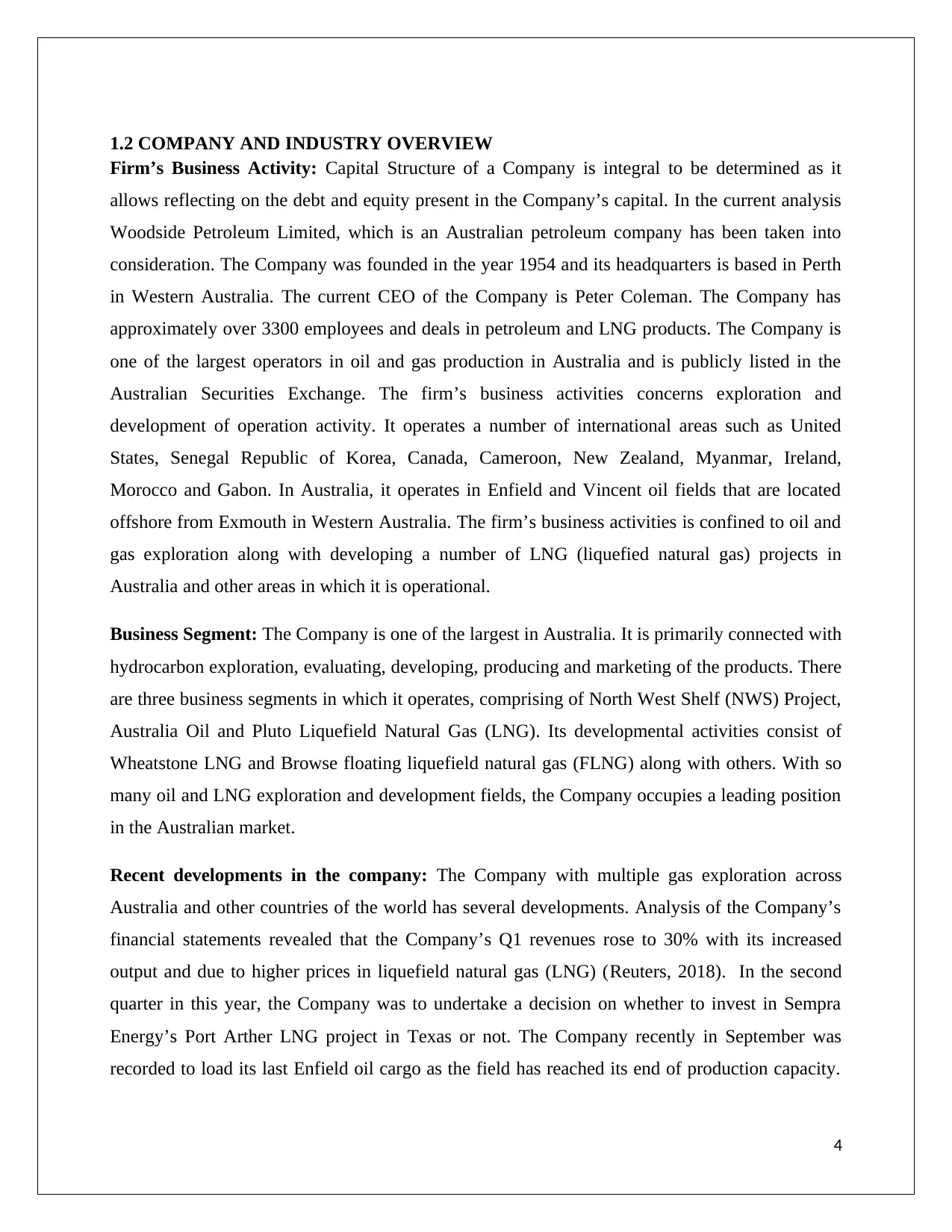
1.2 COMPANY AND INDUSTRY OVERVIEW
Firm’s Business Activity: Capital Structure of a Company is integral to be determined as it
allows reflecting on the debt and equity present in the Company’s capital. In the current analysis
Woodside Petroleum Limited, which is an Australian petroleum company has been taken into
consideration. The Company was founded in the year 1954 and its headquarters is based in Perth
in Western Australia. The current CEO of the Company is Peter Coleman. The Company has
approximately over 3300 employees and deals in petroleum and LNG products. The Company is
one of the largest operators in oil and gas production in Australia and is publicly listed in the
Australian Securities Exchange. The firm’s business activities concerns exploration and
development of operation activity. It operates a number of international areas such as United
States, Senegal Republic of Korea, Canada, Cameroon, New Zealand, Myanmar, Ireland,
Morocco and Gabon. In Australia, it operates in Enfield and Vincent oil fields that are located
offshore from Exmouth in Western Australia. The firm’s business activities is confined to oil and
gas exploration along with developing a number of LNG (liquefied natural gas) projects in
Australia and other areas in which it is operational.
Business Segment: The Company is one of the largest in Australia. It is primarily connected with
hydrocarbon exploration, evaluating, developing, producing and marketing of the products. There
are three business segments in which it operates, comprising of North West Shelf (NWS) Project,
Australia Oil and Pluto Liquefield Natural Gas (LNG). Its developmental activities consist of
Wheatstone LNG and Browse floating liquefield natural gas (FLNG) along with others. With so
many oil and LNG exploration and development fields, the Company occupies a leading position
in the Australian market.
Recent developments in the company: The Company with multiple gas exploration across
Australia and other countries of the world has several developments. Analysis of the Company’s
financial statements revealed that the Company’s Q1 revenues rose to 30% with its increased
output and due to higher prices in liquefield natural gas (LNG) (Reuters, 2018). In the second
quarter in this year, the Company was to undertake a decision on whether to invest in Sempra
Energy’s Port Arther LNG project in Texas or not. The Company recently in September was
recorded to load its last Enfield oil cargo as the field has reached its end of production capacity.
4
Firm’s Business Activity: Capital Structure of a Company is integral to be determined as it
allows reflecting on the debt and equity present in the Company’s capital. In the current analysis
Woodside Petroleum Limited, which is an Australian petroleum company has been taken into
consideration. The Company was founded in the year 1954 and its headquarters is based in Perth
in Western Australia. The current CEO of the Company is Peter Coleman. The Company has
approximately over 3300 employees and deals in petroleum and LNG products. The Company is
one of the largest operators in oil and gas production in Australia and is publicly listed in the
Australian Securities Exchange. The firm’s business activities concerns exploration and
development of operation activity. It operates a number of international areas such as United
States, Senegal Republic of Korea, Canada, Cameroon, New Zealand, Myanmar, Ireland,
Morocco and Gabon. In Australia, it operates in Enfield and Vincent oil fields that are located
offshore from Exmouth in Western Australia. The firm’s business activities is confined to oil and
gas exploration along with developing a number of LNG (liquefied natural gas) projects in
Australia and other areas in which it is operational.
Business Segment: The Company is one of the largest in Australia. It is primarily connected with
hydrocarbon exploration, evaluating, developing, producing and marketing of the products. There
are three business segments in which it operates, comprising of North West Shelf (NWS) Project,
Australia Oil and Pluto Liquefield Natural Gas (LNG). Its developmental activities consist of
Wheatstone LNG and Browse floating liquefield natural gas (FLNG) along with others. With so
many oil and LNG exploration and development fields, the Company occupies a leading position
in the Australian market.
Recent developments in the company: The Company with multiple gas exploration across
Australia and other countries of the world has several developments. Analysis of the Company’s
financial statements revealed that the Company’s Q1 revenues rose to 30% with its increased
output and due to higher prices in liquefield natural gas (LNG) (Reuters, 2018). In the second
quarter in this year, the Company was to undertake a decision on whether to invest in Sempra
Energy’s Port Arther LNG project in Texas or not. The Company recently in September was
recorded to load its last Enfield oil cargo as the field has reached its end of production capacity.
4
Paraphrase This Document
Need a fresh take? Get an instant paraphrase of this document with our AI Paraphraser
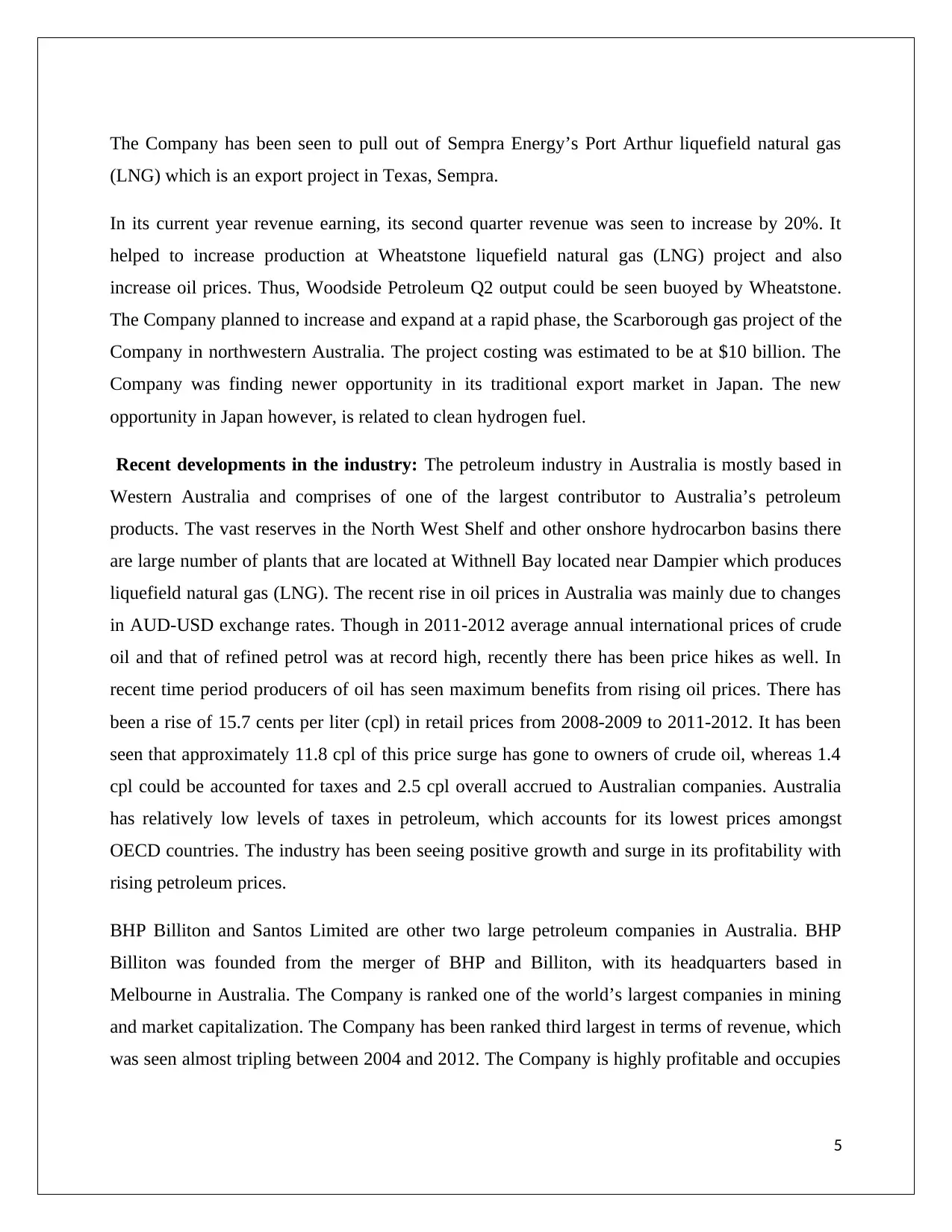
The Company has been seen to pull out of Sempra Energy’s Port Arthur liquefield natural gas
(LNG) which is an export project in Texas, Sempra.
In its current year revenue earning, its second quarter revenue was seen to increase by 20%. It
helped to increase production at Wheatstone liquefield natural gas (LNG) project and also
increase oil prices. Thus, Woodside Petroleum Q2 output could be seen buoyed by Wheatstone.
The Company planned to increase and expand at a rapid phase, the Scarborough gas project of the
Company in northwestern Australia. The project costing was estimated to be at $10 billion. The
Company was finding newer opportunity in its traditional export market in Japan. The new
opportunity in Japan however, is related to clean hydrogen fuel.
Recent developments in the industry: The petroleum industry in Australia is mostly based in
Western Australia and comprises of one of the largest contributor to Australia’s petroleum
products. The vast reserves in the North West Shelf and other onshore hydrocarbon basins there
are large number of plants that are located at Withnell Bay located near Dampier which produces
liquefield natural gas (LNG). The recent rise in oil prices in Australia was mainly due to changes
in AUD-USD exchange rates. Though in 2011-2012 average annual international prices of crude
oil and that of refined petrol was at record high, recently there has been price hikes as well. In
recent time period producers of oil has seen maximum benefits from rising oil prices. There has
been a rise of 15.7 cents per liter (cpl) in retail prices from 2008-2009 to 2011-2012. It has been
seen that approximately 11.8 cpl of this price surge has gone to owners of crude oil, whereas 1.4
cpl could be accounted for taxes and 2.5 cpl overall accrued to Australian companies. Australia
has relatively low levels of taxes in petroleum, which accounts for its lowest prices amongst
OECD countries. The industry has been seeing positive growth and surge in its profitability with
rising petroleum prices.
BHP Billiton and Santos Limited are other two large petroleum companies in Australia. BHP
Billiton was founded from the merger of BHP and Billiton, with its headquarters based in
Melbourne in Australia. The Company is ranked one of the world’s largest companies in mining
and market capitalization. The Company has been ranked third largest in terms of revenue, which
was seen almost tripling between 2004 and 2012. The Company is highly profitable and occupies
5
(LNG) which is an export project in Texas, Sempra.
In its current year revenue earning, its second quarter revenue was seen to increase by 20%. It
helped to increase production at Wheatstone liquefield natural gas (LNG) project and also
increase oil prices. Thus, Woodside Petroleum Q2 output could be seen buoyed by Wheatstone.
The Company planned to increase and expand at a rapid phase, the Scarborough gas project of the
Company in northwestern Australia. The project costing was estimated to be at $10 billion. The
Company was finding newer opportunity in its traditional export market in Japan. The new
opportunity in Japan however, is related to clean hydrogen fuel.
Recent developments in the industry: The petroleum industry in Australia is mostly based in
Western Australia and comprises of one of the largest contributor to Australia’s petroleum
products. The vast reserves in the North West Shelf and other onshore hydrocarbon basins there
are large number of plants that are located at Withnell Bay located near Dampier which produces
liquefield natural gas (LNG). The recent rise in oil prices in Australia was mainly due to changes
in AUD-USD exchange rates. Though in 2011-2012 average annual international prices of crude
oil and that of refined petrol was at record high, recently there has been price hikes as well. In
recent time period producers of oil has seen maximum benefits from rising oil prices. There has
been a rise of 15.7 cents per liter (cpl) in retail prices from 2008-2009 to 2011-2012. It has been
seen that approximately 11.8 cpl of this price surge has gone to owners of crude oil, whereas 1.4
cpl could be accounted for taxes and 2.5 cpl overall accrued to Australian companies. Australia
has relatively low levels of taxes in petroleum, which accounts for its lowest prices amongst
OECD countries. The industry has been seeing positive growth and surge in its profitability with
rising petroleum prices.
BHP Billiton and Santos Limited are other two large petroleum companies in Australia. BHP
Billiton was founded from the merger of BHP and Billiton, with its headquarters based in
Melbourne in Australia. The Company is ranked one of the world’s largest companies in mining
and market capitalization. The Company has been ranked third largest in terms of revenue, which
was seen almost tripling between 2004 and 2012. The Company is highly profitable and occupies
5
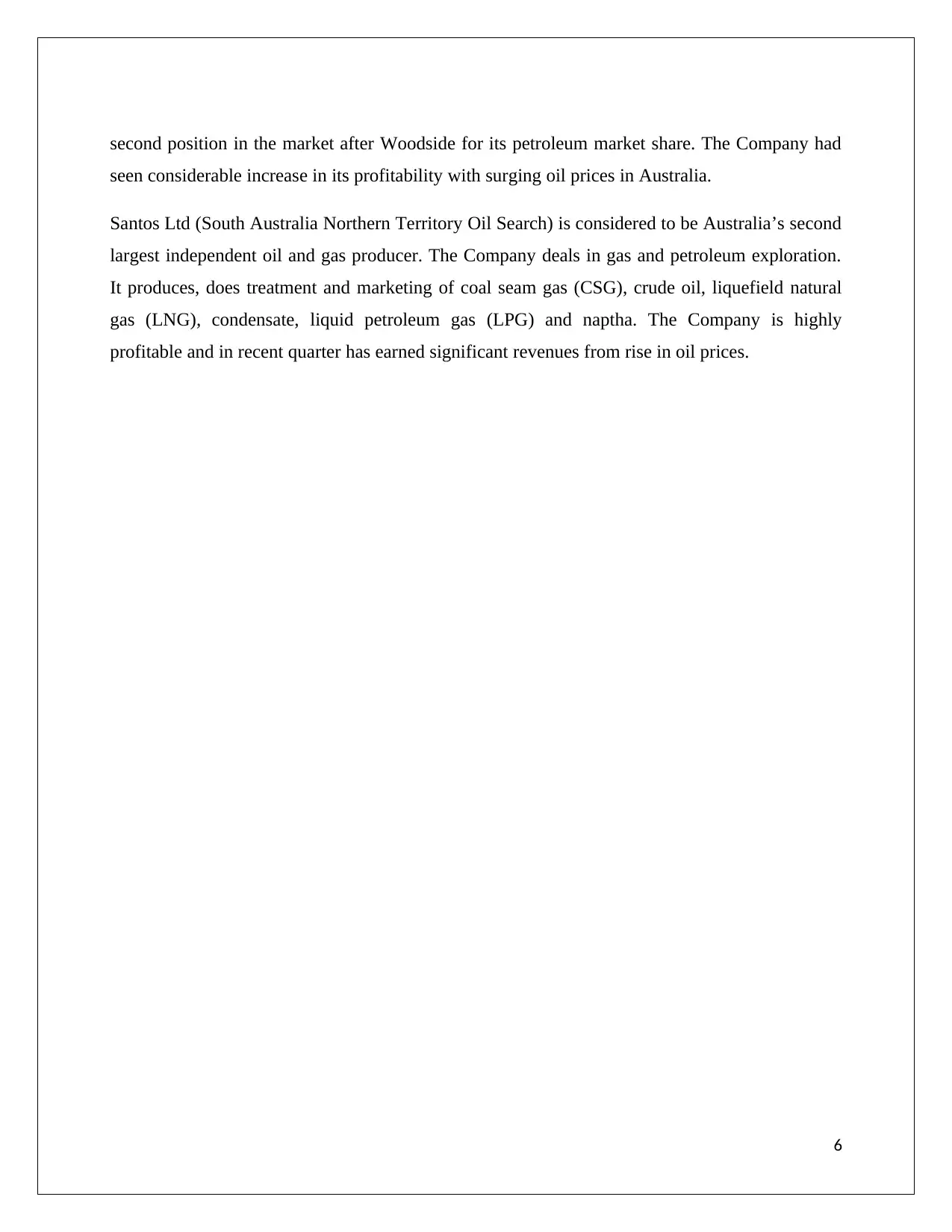
second position in the market after Woodside for its petroleum market share. The Company had
seen considerable increase in its profitability with surging oil prices in Australia.
Santos Ltd (South Australia Northern Territory Oil Search) is considered to be Australia’s second
largest independent oil and gas producer. The Company deals in gas and petroleum exploration.
It produces, does treatment and marketing of coal seam gas (CSG), crude oil, liquefield natural
gas (LNG), condensate, liquid petroleum gas (LPG) and naptha. The Company is highly
profitable and in recent quarter has earned significant revenues from rise in oil prices.
6
seen considerable increase in its profitability with surging oil prices in Australia.
Santos Ltd (South Australia Northern Territory Oil Search) is considered to be Australia’s second
largest independent oil and gas producer. The Company deals in gas and petroleum exploration.
It produces, does treatment and marketing of coal seam gas (CSG), crude oil, liquefield natural
gas (LNG), condensate, liquid petroleum gas (LPG) and naptha. The Company is highly
profitable and in recent quarter has earned significant revenues from rise in oil prices.
6
You're viewing a preview
Unlock full access by subscribing today!
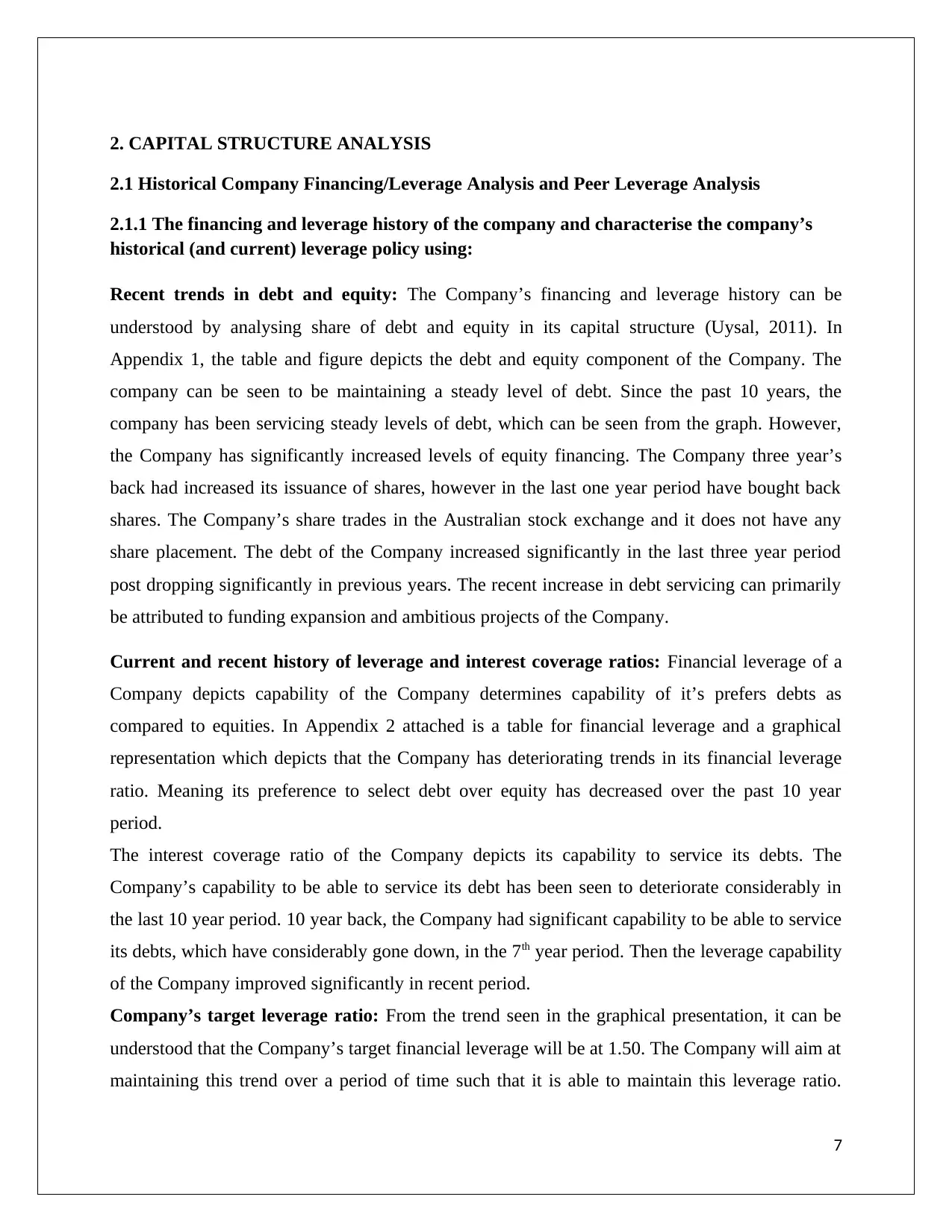
2. CAPITAL STRUCTURE ANALYSIS
2.1 Historical Company Financing/Leverage Analysis and Peer Leverage Analysis
2.1.1 The financing and leverage history of the company and characterise the company’s
historical (and current) leverage policy using:
Recent trends in debt and equity: The Company’s financing and leverage history can be
understood by analysing share of debt and equity in its capital structure (Uysal, 2011). In
Appendix 1, the table and figure depicts the debt and equity component of the Company. The
company can be seen to be maintaining a steady level of debt. Since the past 10 years, the
company has been servicing steady levels of debt, which can be seen from the graph. However,
the Company has significantly increased levels of equity financing. The Company three year’s
back had increased its issuance of shares, however in the last one year period have bought back
shares. The Company’s share trades in the Australian stock exchange and it does not have any
share placement. The debt of the Company increased significantly in the last three year period
post dropping significantly in previous years. The recent increase in debt servicing can primarily
be attributed to funding expansion and ambitious projects of the Company.
Current and recent history of leverage and interest coverage ratios: Financial leverage of a
Company depicts capability of the Company determines capability of it’s prefers debts as
compared to equities. In Appendix 2 attached is a table for financial leverage and a graphical
representation which depicts that the Company has deteriorating trends in its financial leverage
ratio. Meaning its preference to select debt over equity has decreased over the past 10 year
period.
The interest coverage ratio of the Company depicts its capability to service its debts. The
Company’s capability to be able to service its debt has been seen to deteriorate considerably in
the last 10 year period. 10 year back, the Company had significant capability to be able to service
its debts, which have considerably gone down, in the 7th year period. Then the leverage capability
of the Company improved significantly in recent period.
Company’s target leverage ratio: From the trend seen in the graphical presentation, it can be
understood that the Company’s target financial leverage will be at 1.50. The Company will aim at
maintaining this trend over a period of time such that it is able to maintain this leverage ratio.
7
2.1 Historical Company Financing/Leverage Analysis and Peer Leverage Analysis
2.1.1 The financing and leverage history of the company and characterise the company’s
historical (and current) leverage policy using:
Recent trends in debt and equity: The Company’s financing and leverage history can be
understood by analysing share of debt and equity in its capital structure (Uysal, 2011). In
Appendix 1, the table and figure depicts the debt and equity component of the Company. The
company can be seen to be maintaining a steady level of debt. Since the past 10 years, the
company has been servicing steady levels of debt, which can be seen from the graph. However,
the Company has significantly increased levels of equity financing. The Company three year’s
back had increased its issuance of shares, however in the last one year period have bought back
shares. The Company’s share trades in the Australian stock exchange and it does not have any
share placement. The debt of the Company increased significantly in the last three year period
post dropping significantly in previous years. The recent increase in debt servicing can primarily
be attributed to funding expansion and ambitious projects of the Company.
Current and recent history of leverage and interest coverage ratios: Financial leverage of a
Company depicts capability of the Company determines capability of it’s prefers debts as
compared to equities. In Appendix 2 attached is a table for financial leverage and a graphical
representation which depicts that the Company has deteriorating trends in its financial leverage
ratio. Meaning its preference to select debt over equity has decreased over the past 10 year
period.
The interest coverage ratio of the Company depicts its capability to service its debts. The
Company’s capability to be able to service its debt has been seen to deteriorate considerably in
the last 10 year period. 10 year back, the Company had significant capability to be able to service
its debts, which have considerably gone down, in the 7th year period. Then the leverage capability
of the Company improved significantly in recent period.
Company’s target leverage ratio: From the trend seen in the graphical presentation, it can be
understood that the Company’s target financial leverage will be at 1.50. The Company will aim at
maintaining this trend over a period of time such that it is able to maintain this leverage ratio.
7
Paraphrase This Document
Need a fresh take? Get an instant paraphrase of this document with our AI Paraphraser
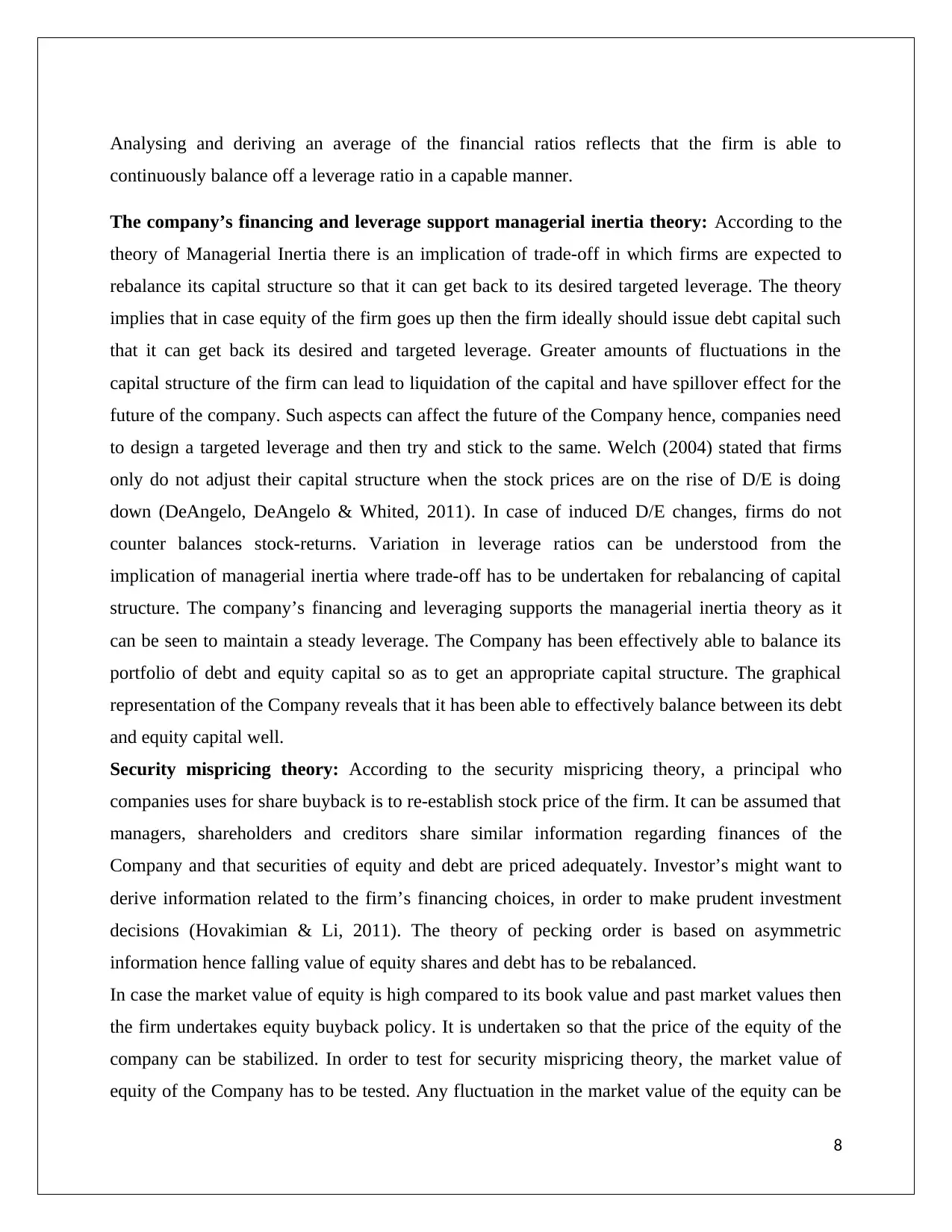
Analysing and deriving an average of the financial ratios reflects that the firm is able to
continuously balance off a leverage ratio in a capable manner.
The company’s financing and leverage support managerial inertia theory: According to the
theory of Managerial Inertia there is an implication of trade-off in which firms are expected to
rebalance its capital structure so that it can get back to its desired targeted leverage. The theory
implies that in case equity of the firm goes up then the firm ideally should issue debt capital such
that it can get back its desired and targeted leverage. Greater amounts of fluctuations in the
capital structure of the firm can lead to liquidation of the capital and have spillover effect for the
future of the company. Such aspects can affect the future of the Company hence, companies need
to design a targeted leverage and then try and stick to the same. Welch (2004) stated that firms
only do not adjust their capital structure when the stock prices are on the rise of D/E is doing
down (DeAngelo, DeAngelo & Whited, 2011). In case of induced D/E changes, firms do not
counter balances stock-returns. Variation in leverage ratios can be understood from the
implication of managerial inertia where trade-off has to be undertaken for rebalancing of capital
structure. The company’s financing and leveraging supports the managerial inertia theory as it
can be seen to maintain a steady leverage. The Company has been effectively able to balance its
portfolio of debt and equity capital so as to get an appropriate capital structure. The graphical
representation of the Company reveals that it has been able to effectively balance between its debt
and equity capital well.
Security mispricing theory: According to the security mispricing theory, a principal who
companies uses for share buyback is to re-establish stock price of the firm. It can be assumed that
managers, shareholders and creditors share similar information regarding finances of the
Company and that securities of equity and debt are priced adequately. Investor’s might want to
derive information related to the firm’s financing choices, in order to make prudent investment
decisions (Hovakimian & Li, 2011). The theory of pecking order is based on asymmetric
information hence falling value of equity shares and debt has to be rebalanced.
In case the market value of equity is high compared to its book value and past market values then
the firm undertakes equity buyback policy. It is undertaken so that the price of the equity of the
company can be stabilized. In order to test for security mispricing theory, the market value of
equity of the Company has to be tested. Any fluctuation in the market value of the equity can be
8
continuously balance off a leverage ratio in a capable manner.
The company’s financing and leverage support managerial inertia theory: According to the
theory of Managerial Inertia there is an implication of trade-off in which firms are expected to
rebalance its capital structure so that it can get back to its desired targeted leverage. The theory
implies that in case equity of the firm goes up then the firm ideally should issue debt capital such
that it can get back its desired and targeted leverage. Greater amounts of fluctuations in the
capital structure of the firm can lead to liquidation of the capital and have spillover effect for the
future of the company. Such aspects can affect the future of the Company hence, companies need
to design a targeted leverage and then try and stick to the same. Welch (2004) stated that firms
only do not adjust their capital structure when the stock prices are on the rise of D/E is doing
down (DeAngelo, DeAngelo & Whited, 2011). In case of induced D/E changes, firms do not
counter balances stock-returns. Variation in leverage ratios can be understood from the
implication of managerial inertia where trade-off has to be undertaken for rebalancing of capital
structure. The company’s financing and leveraging supports the managerial inertia theory as it
can be seen to maintain a steady leverage. The Company has been effectively able to balance its
portfolio of debt and equity capital so as to get an appropriate capital structure. The graphical
representation of the Company reveals that it has been able to effectively balance between its debt
and equity capital well.
Security mispricing theory: According to the security mispricing theory, a principal who
companies uses for share buyback is to re-establish stock price of the firm. It can be assumed that
managers, shareholders and creditors share similar information regarding finances of the
Company and that securities of equity and debt are priced adequately. Investor’s might want to
derive information related to the firm’s financing choices, in order to make prudent investment
decisions (Hovakimian & Li, 2011). The theory of pecking order is based on asymmetric
information hence falling value of equity shares and debt has to be rebalanced.
In case the market value of equity is high compared to its book value and past market values then
the firm undertakes equity buyback policy. It is undertaken so that the price of the equity of the
company can be stabilized. In order to test for security mispricing theory, the market value of
equity of the Company has to be tested. Any fluctuation in the market value of the equity can be
8
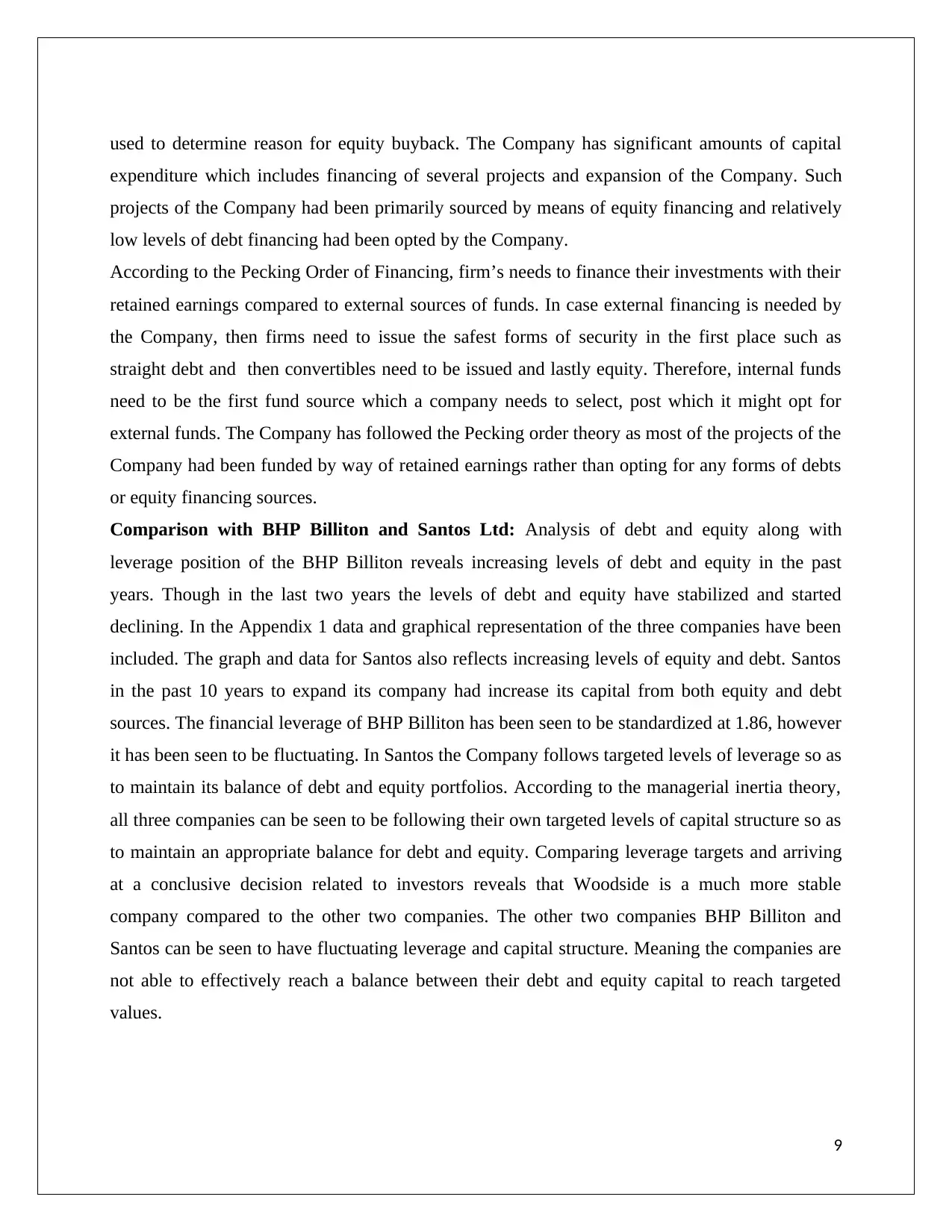
used to determine reason for equity buyback. The Company has significant amounts of capital
expenditure which includes financing of several projects and expansion of the Company. Such
projects of the Company had been primarily sourced by means of equity financing and relatively
low levels of debt financing had been opted by the Company.
According to the Pecking Order of Financing, firm’s needs to finance their investments with their
retained earnings compared to external sources of funds. In case external financing is needed by
the Company, then firms need to issue the safest forms of security in the first place such as
straight debt and then convertibles need to be issued and lastly equity. Therefore, internal funds
need to be the first fund source which a company needs to select, post which it might opt for
external funds. The Company has followed the Pecking order theory as most of the projects of the
Company had been funded by way of retained earnings rather than opting for any forms of debts
or equity financing sources.
Comparison with BHP Billiton and Santos Ltd: Analysis of debt and equity along with
leverage position of the BHP Billiton reveals increasing levels of debt and equity in the past
years. Though in the last two years the levels of debt and equity have stabilized and started
declining. In the Appendix 1 data and graphical representation of the three companies have been
included. The graph and data for Santos also reflects increasing levels of equity and debt. Santos
in the past 10 years to expand its company had increase its capital from both equity and debt
sources. The financial leverage of BHP Billiton has been seen to be standardized at 1.86, however
it has been seen to be fluctuating. In Santos the Company follows targeted levels of leverage so as
to maintain its balance of debt and equity portfolios. According to the managerial inertia theory,
all three companies can be seen to be following their own targeted levels of capital structure so as
to maintain an appropriate balance for debt and equity. Comparing leverage targets and arriving
at a conclusive decision related to investors reveals that Woodside is a much more stable
company compared to the other two companies. The other two companies BHP Billiton and
Santos can be seen to have fluctuating leverage and capital structure. Meaning the companies are
not able to effectively reach a balance between their debt and equity capital to reach targeted
values.
9
expenditure which includes financing of several projects and expansion of the Company. Such
projects of the Company had been primarily sourced by means of equity financing and relatively
low levels of debt financing had been opted by the Company.
According to the Pecking Order of Financing, firm’s needs to finance their investments with their
retained earnings compared to external sources of funds. In case external financing is needed by
the Company, then firms need to issue the safest forms of security in the first place such as
straight debt and then convertibles need to be issued and lastly equity. Therefore, internal funds
need to be the first fund source which a company needs to select, post which it might opt for
external funds. The Company has followed the Pecking order theory as most of the projects of the
Company had been funded by way of retained earnings rather than opting for any forms of debts
or equity financing sources.
Comparison with BHP Billiton and Santos Ltd: Analysis of debt and equity along with
leverage position of the BHP Billiton reveals increasing levels of debt and equity in the past
years. Though in the last two years the levels of debt and equity have stabilized and started
declining. In the Appendix 1 data and graphical representation of the three companies have been
included. The graph and data for Santos also reflects increasing levels of equity and debt. Santos
in the past 10 years to expand its company had increase its capital from both equity and debt
sources. The financial leverage of BHP Billiton has been seen to be standardized at 1.86, however
it has been seen to be fluctuating. In Santos the Company follows targeted levels of leverage so as
to maintain its balance of debt and equity portfolios. According to the managerial inertia theory,
all three companies can be seen to be following their own targeted levels of capital structure so as
to maintain an appropriate balance for debt and equity. Comparing leverage targets and arriving
at a conclusive decision related to investors reveals that Woodside is a much more stable
company compared to the other two companies. The other two companies BHP Billiton and
Santos can be seen to have fluctuating leverage and capital structure. Meaning the companies are
not able to effectively reach a balance between their debt and equity capital to reach targeted
values.
9
You're viewing a preview
Unlock full access by subscribing today!
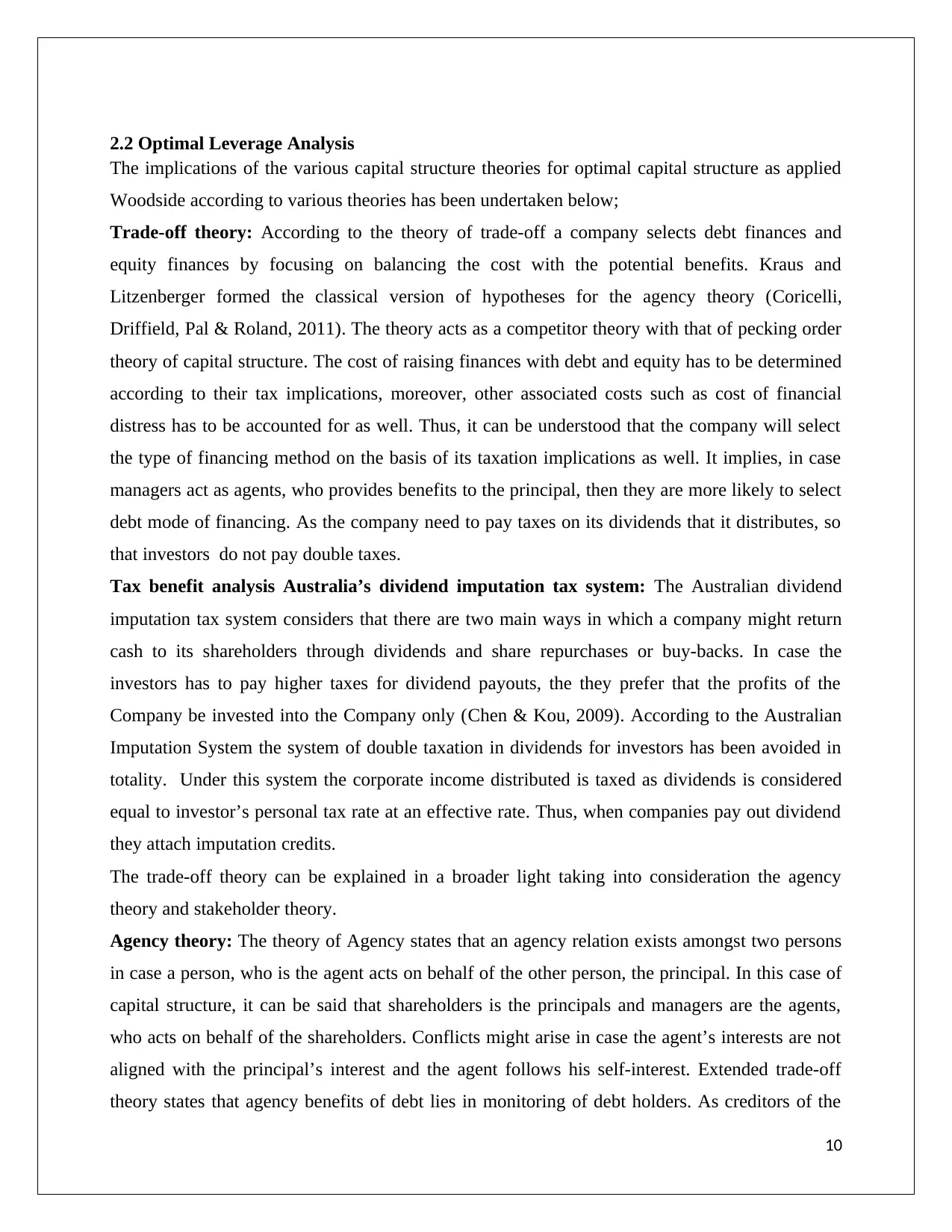
2.2 Optimal Leverage Analysis
The implications of the various capital structure theories for optimal capital structure as applied
Woodside according to various theories has been undertaken below;
Trade-off theory: According to the theory of trade-off a company selects debt finances and
equity finances by focusing on balancing the cost with the potential benefits. Kraus and
Litzenberger formed the classical version of hypotheses for the agency theory (Coricelli,
Driffield, Pal & Roland, 2011). The theory acts as a competitor theory with that of pecking order
theory of capital structure. The cost of raising finances with debt and equity has to be determined
according to their tax implications, moreover, other associated costs such as cost of financial
distress has to be accounted for as well. Thus, it can be understood that the company will select
the type of financing method on the basis of its taxation implications as well. It implies, in case
managers act as agents, who provides benefits to the principal, then they are more likely to select
debt mode of financing. As the company need to pay taxes on its dividends that it distributes, so
that investors do not pay double taxes.
Tax benefit analysis Australia’s dividend imputation tax system: The Australian dividend
imputation tax system considers that there are two main ways in which a company might return
cash to its shareholders through dividends and share repurchases or buy-backs. In case the
investors has to pay higher taxes for dividend payouts, the they prefer that the profits of the
Company be invested into the Company only (Chen & Kou, 2009). According to the Australian
Imputation System the system of double taxation in dividends for investors has been avoided in
totality. Under this system the corporate income distributed is taxed as dividends is considered
equal to investor’s personal tax rate at an effective rate. Thus, when companies pay out dividend
they attach imputation credits.
The trade-off theory can be explained in a broader light taking into consideration the agency
theory and stakeholder theory.
Agency theory: The theory of Agency states that an agency relation exists amongst two persons
in case a person, who is the agent acts on behalf of the other person, the principal. In this case of
capital structure, it can be said that shareholders is the principals and managers are the agents,
who acts on behalf of the shareholders. Conflicts might arise in case the agent’s interests are not
aligned with the principal’s interest and the agent follows his self-interest. Extended trade-off
theory states that agency benefits of debt lies in monitoring of debt holders. As creditors of the
10
The implications of the various capital structure theories for optimal capital structure as applied
Woodside according to various theories has been undertaken below;
Trade-off theory: According to the theory of trade-off a company selects debt finances and
equity finances by focusing on balancing the cost with the potential benefits. Kraus and
Litzenberger formed the classical version of hypotheses for the agency theory (Coricelli,
Driffield, Pal & Roland, 2011). The theory acts as a competitor theory with that of pecking order
theory of capital structure. The cost of raising finances with debt and equity has to be determined
according to their tax implications, moreover, other associated costs such as cost of financial
distress has to be accounted for as well. Thus, it can be understood that the company will select
the type of financing method on the basis of its taxation implications as well. It implies, in case
managers act as agents, who provides benefits to the principal, then they are more likely to select
debt mode of financing. As the company need to pay taxes on its dividends that it distributes, so
that investors do not pay double taxes.
Tax benefit analysis Australia’s dividend imputation tax system: The Australian dividend
imputation tax system considers that there are two main ways in which a company might return
cash to its shareholders through dividends and share repurchases or buy-backs. In case the
investors has to pay higher taxes for dividend payouts, the they prefer that the profits of the
Company be invested into the Company only (Chen & Kou, 2009). According to the Australian
Imputation System the system of double taxation in dividends for investors has been avoided in
totality. Under this system the corporate income distributed is taxed as dividends is considered
equal to investor’s personal tax rate at an effective rate. Thus, when companies pay out dividend
they attach imputation credits.
The trade-off theory can be explained in a broader light taking into consideration the agency
theory and stakeholder theory.
Agency theory: The theory of Agency states that an agency relation exists amongst two persons
in case a person, who is the agent acts on behalf of the other person, the principal. In this case of
capital structure, it can be said that shareholders is the principals and managers are the agents,
who acts on behalf of the shareholders. Conflicts might arise in case the agent’s interests are not
aligned with the principal’s interest and the agent follows his self-interest. Extended trade-off
theory states that agency benefits of debt lies in monitoring of debt holders. As creditors of the
10
Paraphrase This Document
Need a fresh take? Get an instant paraphrase of this document with our AI Paraphraser
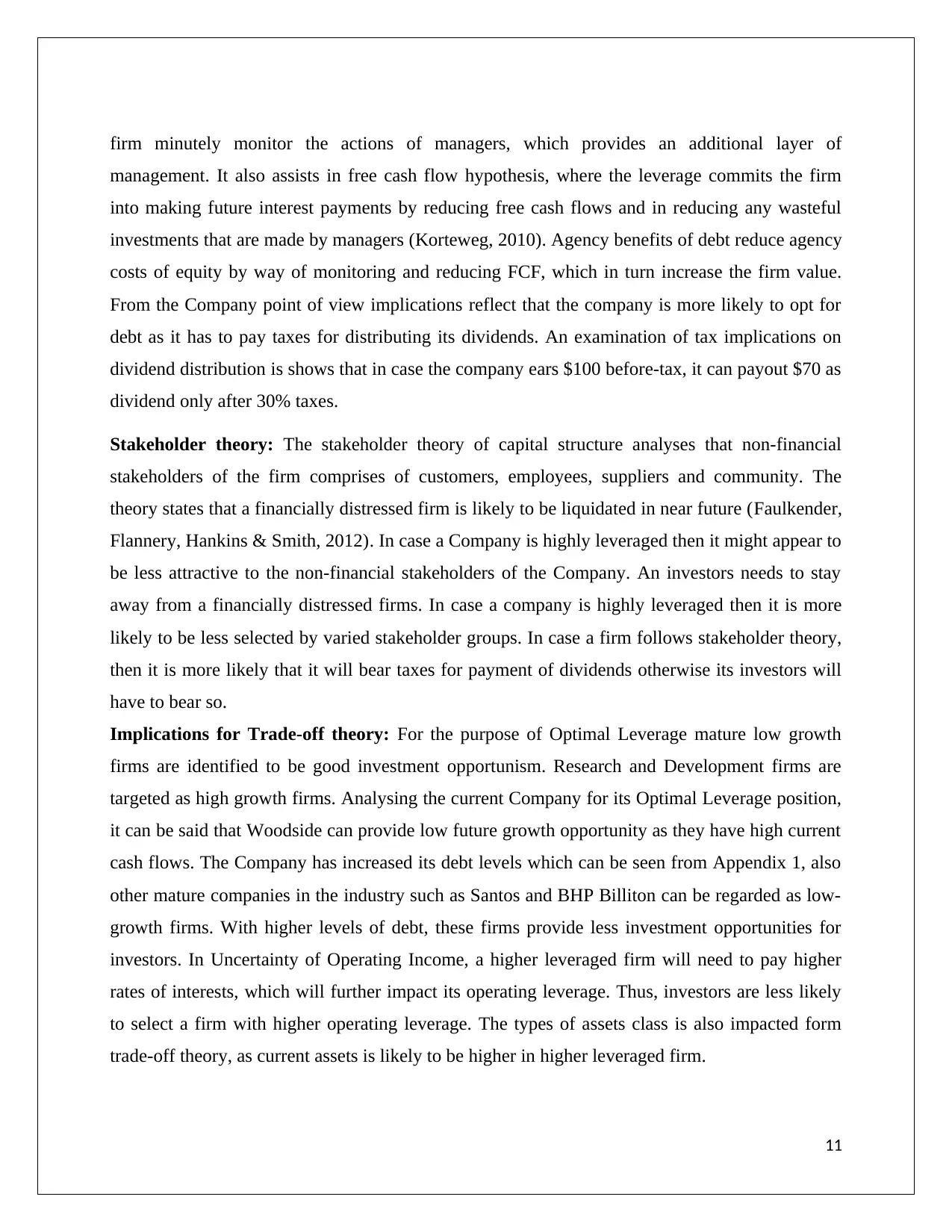
firm minutely monitor the actions of managers, which provides an additional layer of
management. It also assists in free cash flow hypothesis, where the leverage commits the firm
into making future interest payments by reducing free cash flows and in reducing any wasteful
investments that are made by managers (Korteweg, 2010). Agency benefits of debt reduce agency
costs of equity by way of monitoring and reducing FCF, which in turn increase the firm value.
From the Company point of view implications reflect that the company is more likely to opt for
debt as it has to pay taxes for distributing its dividends. An examination of tax implications on
dividend distribution is shows that in case the company ears $100 before-tax, it can payout $70 as
dividend only after 30% taxes.
Stakeholder theory: The stakeholder theory of capital structure analyses that non-financial
stakeholders of the firm comprises of customers, employees, suppliers and community. The
theory states that a financially distressed firm is likely to be liquidated in near future (Faulkender,
Flannery, Hankins & Smith, 2012). In case a Company is highly leveraged then it might appear to
be less attractive to the non-financial stakeholders of the Company. An investors needs to stay
away from a financially distressed firms. In case a company is highly leveraged then it is more
likely to be less selected by varied stakeholder groups. In case a firm follows stakeholder theory,
then it is more likely that it will bear taxes for payment of dividends otherwise its investors will
have to bear so.
Implications for Trade-off theory: For the purpose of Optimal Leverage mature low growth
firms are identified to be good investment opportunism. Research and Development firms are
targeted as high growth firms. Analysing the current Company for its Optimal Leverage position,
it can be said that Woodside can provide low future growth opportunity as they have high current
cash flows. The Company has increased its debt levels which can be seen from Appendix 1, also
other mature companies in the industry such as Santos and BHP Billiton can be regarded as low-
growth firms. With higher levels of debt, these firms provide less investment opportunities for
investors. In Uncertainty of Operating Income, a higher leveraged firm will need to pay higher
rates of interests, which will further impact its operating leverage. Thus, investors are less likely
to select a firm with higher operating leverage. The types of assets class is also impacted form
trade-off theory, as current assets is likely to be higher in higher leveraged firm.
11
management. It also assists in free cash flow hypothesis, where the leverage commits the firm
into making future interest payments by reducing free cash flows and in reducing any wasteful
investments that are made by managers (Korteweg, 2010). Agency benefits of debt reduce agency
costs of equity by way of monitoring and reducing FCF, which in turn increase the firm value.
From the Company point of view implications reflect that the company is more likely to opt for
debt as it has to pay taxes for distributing its dividends. An examination of tax implications on
dividend distribution is shows that in case the company ears $100 before-tax, it can payout $70 as
dividend only after 30% taxes.
Stakeholder theory: The stakeholder theory of capital structure analyses that non-financial
stakeholders of the firm comprises of customers, employees, suppliers and community. The
theory states that a financially distressed firm is likely to be liquidated in near future (Faulkender,
Flannery, Hankins & Smith, 2012). In case a Company is highly leveraged then it might appear to
be less attractive to the non-financial stakeholders of the Company. An investors needs to stay
away from a financially distressed firms. In case a company is highly leveraged then it is more
likely to be less selected by varied stakeholder groups. In case a firm follows stakeholder theory,
then it is more likely that it will bear taxes for payment of dividends otherwise its investors will
have to bear so.
Implications for Trade-off theory: For the purpose of Optimal Leverage mature low growth
firms are identified to be good investment opportunism. Research and Development firms are
targeted as high growth firms. Analysing the current Company for its Optimal Leverage position,
it can be said that Woodside can provide low future growth opportunity as they have high current
cash flows. The Company has increased its debt levels which can be seen from Appendix 1, also
other mature companies in the industry such as Santos and BHP Billiton can be regarded as low-
growth firms. With higher levels of debt, these firms provide less investment opportunities for
investors. In Uncertainty of Operating Income, a higher leveraged firm will need to pay higher
rates of interests, which will further impact its operating leverage. Thus, investors are less likely
to select a firm with higher operating leverage. The types of assets class is also impacted form
trade-off theory, as current assets is likely to be higher in higher leveraged firm.
11

References
Uysal, V.B., 2011. Deviation from the target capital structure and acquisition choices. Journal of
Financial Economics, 102(3), pp.602-620. Retrieved on 4th October 2018, from
https://www.sciencedirect.com/science/article/pii/S0304405X11001620
Hovakimian, A. and Li, G., 2011. In search of conclusive evidence: How to test for adjustment to
target capital structure. Journal of Corporate Finance, 17(1), pp.33-44. Retrieved on 5th October
2018, from https://www.sciencedirect.com/science/article/pii/S0929119910000532
DeAngelo, H., DeAngelo, L. and Whited, T.M., 2011. Capital structure dynamics and transitory
debt. Journal of Financial Economics, 99(2), pp.235-261. Retrieved on 6th October 2018, from
https://www.sciencedirect.com/science/article/pii/S0304405X10002175
Coricelli, F., Driffield, N., Pal, S. and Roland, I., 2011. Optimal leverage and firm performance:
An endogenous threshold analysis. Internet access:< http://people. brunel. ac. uk/~
ecstssp/webfiles/EBRD_Paper_15_April_2011_Final. pdf>,[accessed March 12, 2015]
Korteweg, A., 2010. The net benefits to leverage. The Journal of Finance, 65(6), pp.2137-2170.
Retrieved on 2nd October 2018, from https://onlinelibrary.wiley.com/doi/abs/10.1111/j.1540-
6261.2010.01612.x
Reuters (2018), Retrieved on 3rd October 2018, from
<https://in.reuters.com/finance/stocks/company-news/WPL.AX>
Faulkender, M., Flannery, M.J., Hankins, K.W. and Smith, J.M., 2012. Cash flows and leverage
adjustments. Journal of Financial Economics, 103(3), pp.632-646. Retrieved on 7th October
2018, from https://www.sciencedirect.com/science/article/pii/S0304405X11002583
Chen, N. and Kou, S.G., 2009. Credit spreads, optimal capital structure, and implied volatility
with endogenous default and jump risk. Mathematical Finance: An International Journal of
Mathematics, Statistics and Financial Economics, 19(3), pp.343-378. Retrieved on 1st October
2018, from https://onlinelibrary.wiley.com/doi/abs/10.1111/j.1467-9965.2009.00375.x
12
Uysal, V.B., 2011. Deviation from the target capital structure and acquisition choices. Journal of
Financial Economics, 102(3), pp.602-620. Retrieved on 4th October 2018, from
https://www.sciencedirect.com/science/article/pii/S0304405X11001620
Hovakimian, A. and Li, G., 2011. In search of conclusive evidence: How to test for adjustment to
target capital structure. Journal of Corporate Finance, 17(1), pp.33-44. Retrieved on 5th October
2018, from https://www.sciencedirect.com/science/article/pii/S0929119910000532
DeAngelo, H., DeAngelo, L. and Whited, T.M., 2011. Capital structure dynamics and transitory
debt. Journal of Financial Economics, 99(2), pp.235-261. Retrieved on 6th October 2018, from
https://www.sciencedirect.com/science/article/pii/S0304405X10002175
Coricelli, F., Driffield, N., Pal, S. and Roland, I., 2011. Optimal leverage and firm performance:
An endogenous threshold analysis. Internet access:< http://people. brunel. ac. uk/~
ecstssp/webfiles/EBRD_Paper_15_April_2011_Final. pdf>,[accessed March 12, 2015]
Korteweg, A., 2010. The net benefits to leverage. The Journal of Finance, 65(6), pp.2137-2170.
Retrieved on 2nd October 2018, from https://onlinelibrary.wiley.com/doi/abs/10.1111/j.1540-
6261.2010.01612.x
Reuters (2018), Retrieved on 3rd October 2018, from
<https://in.reuters.com/finance/stocks/company-news/WPL.AX>
Faulkender, M., Flannery, M.J., Hankins, K.W. and Smith, J.M., 2012. Cash flows and leverage
adjustments. Journal of Financial Economics, 103(3), pp.632-646. Retrieved on 7th October
2018, from https://www.sciencedirect.com/science/article/pii/S0304405X11002583
Chen, N. and Kou, S.G., 2009. Credit spreads, optimal capital structure, and implied volatility
with endogenous default and jump risk. Mathematical Finance: An International Journal of
Mathematics, Statistics and Financial Economics, 19(3), pp.343-378. Retrieved on 1st October
2018, from https://onlinelibrary.wiley.com/doi/abs/10.1111/j.1467-9965.2009.00375.x
12
You're viewing a preview
Unlock full access by subscribing today!
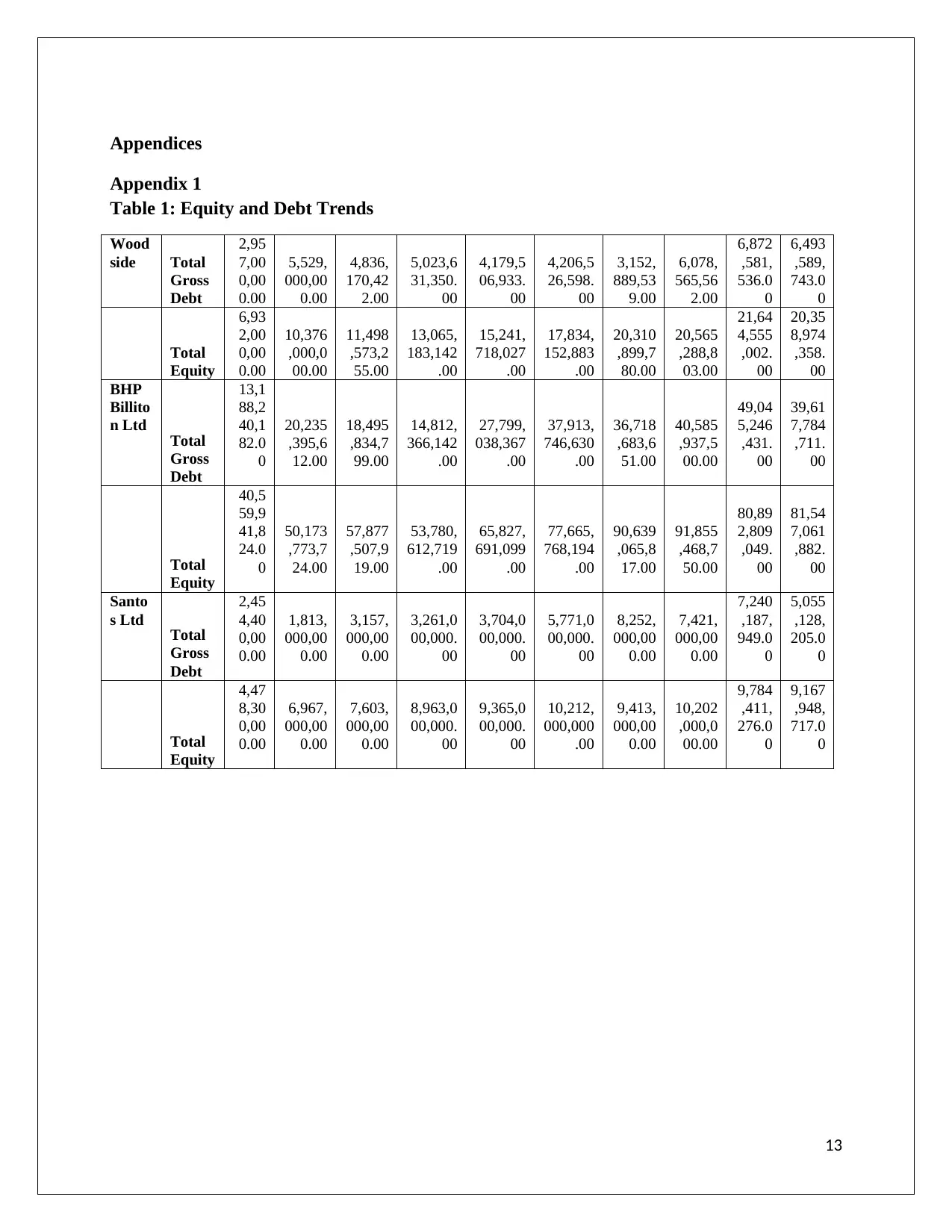
Appendices
Appendix 1
Table 1: Equity and Debt Trends
Wood
side Total
Gross
Debt
2,95
7,00
0,00
0.00
5,529,
000,00
0.00
4,836,
170,42
2.00
5,023,6
31,350.
00
4,179,5
06,933.
00
4,206,5
26,598.
00
3,152,
889,53
9.00
6,078,
565,56
2.00
6,872
,581,
536.0
0
6,493
,589,
743.0
0
Total
Equity
6,93
2,00
0,00
0.00
10,376
,000,0
00.00
11,498
,573,2
55.00
13,065,
183,142
.00
15,241,
718,027
.00
17,834,
152,883
.00
20,310
,899,7
80.00
20,565
,288,8
03.00
21,64
4,555
,002.
00
20,35
8,974
,358.
00
BHP
Billito
n Ltd
Total
Gross
Debt
13,1
88,2
40,1
82.0
0
20,235
,395,6
12.00
18,495
,834,7
99.00
14,812,
366,142
.00
27,799,
038,367
.00
37,913,
746,630
.00
36,718
,683,6
51.00
40,585
,937,5
00.00
49,04
5,246
,431.
00
39,61
7,784
,711.
00
Total
Equity
40,5
59,9
41,8
24.0
0
50,173
,773,7
24.00
57,877
,507,9
19.00
53,780,
612,719
.00
65,827,
691,099
.00
77,665,
768,194
.00
90,639
,065,8
17.00
91,855
,468,7
50.00
80,89
2,809
,049.
00
81,54
7,061
,882.
00
Santo
s Ltd Total
Gross
Debt
2,45
4,40
0,00
0.00
1,813,
000,00
0.00
3,157,
000,00
0.00
3,261,0
00,000.
00
3,704,0
00,000.
00
5,771,0
00,000.
00
8,252,
000,00
0.00
7,421,
000,00
0.00
7,240
,187,
949.0
0
5,055
,128,
205.0
0
Total
Equity
4,47
8,30
0,00
0.00
6,967,
000,00
0.00
7,603,
000,00
0.00
8,963,0
00,000.
00
9,365,0
00,000.
00
10,212,
000,000
.00
9,413,
000,00
0.00
10,202
,000,0
00.00
9,784
,411,
276.0
0
9,167
,948,
717.0
0
13
Appendix 1
Table 1: Equity and Debt Trends
Wood
side Total
Gross
Debt
2,95
7,00
0,00
0.00
5,529,
000,00
0.00
4,836,
170,42
2.00
5,023,6
31,350.
00
4,179,5
06,933.
00
4,206,5
26,598.
00
3,152,
889,53
9.00
6,078,
565,56
2.00
6,872
,581,
536.0
0
6,493
,589,
743.0
0
Total
Equity
6,93
2,00
0,00
0.00
10,376
,000,0
00.00
11,498
,573,2
55.00
13,065,
183,142
.00
15,241,
718,027
.00
17,834,
152,883
.00
20,310
,899,7
80.00
20,565
,288,8
03.00
21,64
4,555
,002.
00
20,35
8,974
,358.
00
BHP
Billito
n Ltd
Total
Gross
Debt
13,1
88,2
40,1
82.0
0
20,235
,395,6
12.00
18,495
,834,7
99.00
14,812,
366,142
.00
27,799,
038,367
.00
37,913,
746,630
.00
36,718
,683,6
51.00
40,585
,937,5
00.00
49,04
5,246
,431.
00
39,61
7,784
,711.
00
Total
Equity
40,5
59,9
41,8
24.0
0
50,173
,773,7
24.00
57,877
,507,9
19.00
53,780,
612,719
.00
65,827,
691,099
.00
77,665,
768,194
.00
90,639
,065,8
17.00
91,855
,468,7
50.00
80,89
2,809
,049.
00
81,54
7,061
,882.
00
Santo
s Ltd Total
Gross
Debt
2,45
4,40
0,00
0.00
1,813,
000,00
0.00
3,157,
000,00
0.00
3,261,0
00,000.
00
3,704,0
00,000.
00
5,771,0
00,000.
00
8,252,
000,00
0.00
7,421,
000,00
0.00
7,240
,187,
949.0
0
5,055
,128,
205.0
0
Total
Equity
4,47
8,30
0,00
0.00
6,967,
000,00
0.00
7,603,
000,00
0.00
8,963,0
00,000.
00
9,365,0
00,000.
00
10,212,
000,000
.00
9,413,
000,00
0.00
10,202
,000,0
00.00
9,784
,411,
276.0
0
9,167
,948,
717.0
0
13
Paraphrase This Document
Need a fresh take? Get an instant paraphrase of this document with our AI Paraphraser
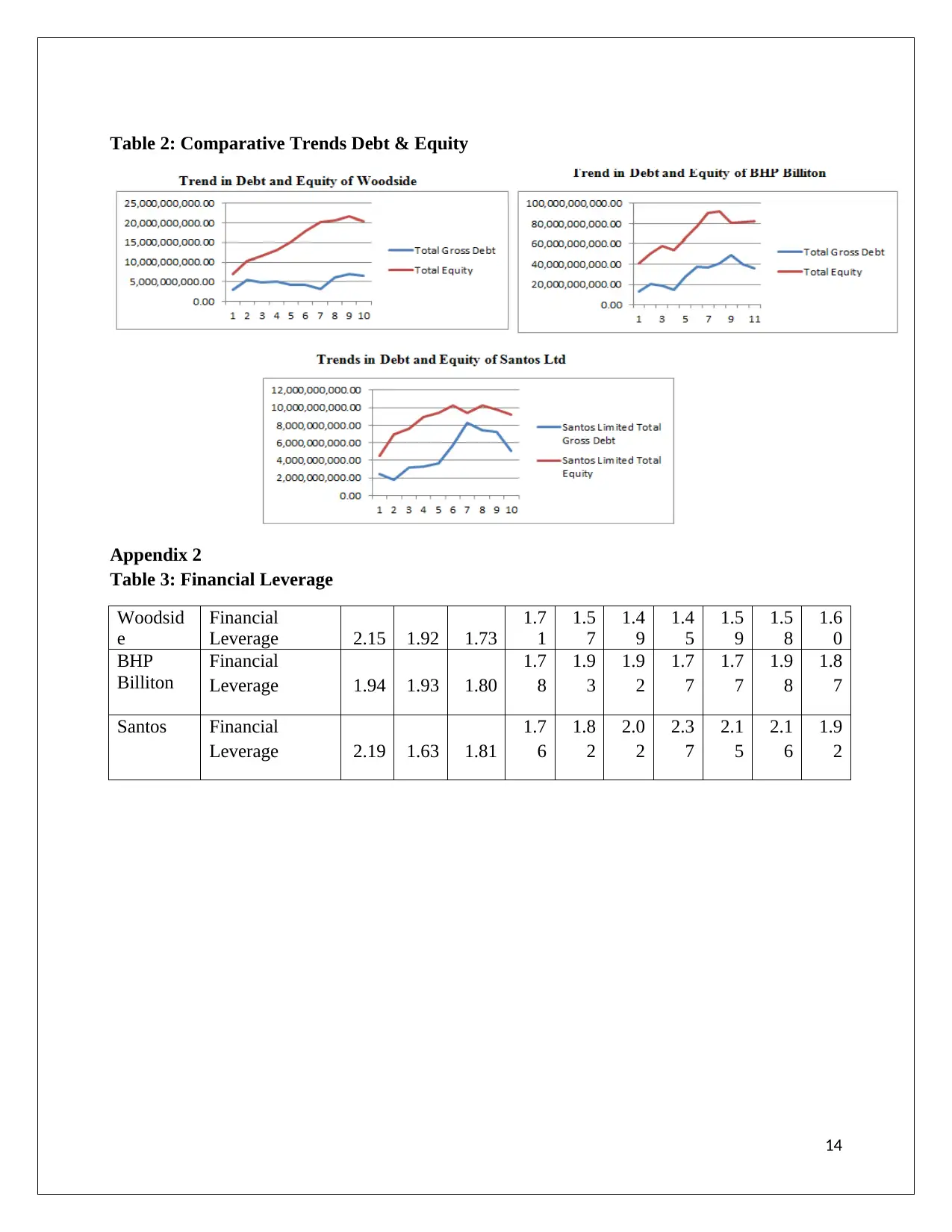
Table 2: Comparative Trends Debt & Equity
Appendix 2
Table 3: Financial Leverage
Woodsid
e
Financial
Leverage 2.15 1.92 1.73
1.7
1
1.5
7
1.4
9
1.4
5
1.5
9
1.5
8
1.6
0
BHP
Billiton
Financial
Leverage 1.94 1.93 1.80
1.7
8
1.9
3
1.9
2
1.7
7
1.7
7
1.9
8
1.8
7
Santos Financial
Leverage 2.19 1.63 1.81
1.7
6
1.8
2
2.0
2
2.3
7
2.1
5
2.1
6
1.9
2
14
Appendix 2
Table 3: Financial Leverage
Woodsid
e
Financial
Leverage 2.15 1.92 1.73
1.7
1
1.5
7
1.4
9
1.4
5
1.5
9
1.5
8
1.6
0
BHP
Billiton
Financial
Leverage 1.94 1.93 1.80
1.7
8
1.9
3
1.9
2
1.7
7
1.7
7
1.9
8
1.8
7
Santos Financial
Leverage 2.19 1.63 1.81
1.7
6
1.8
2
2.0
2
2.3
7
2.1
5
2.1
6
1.9
2
14
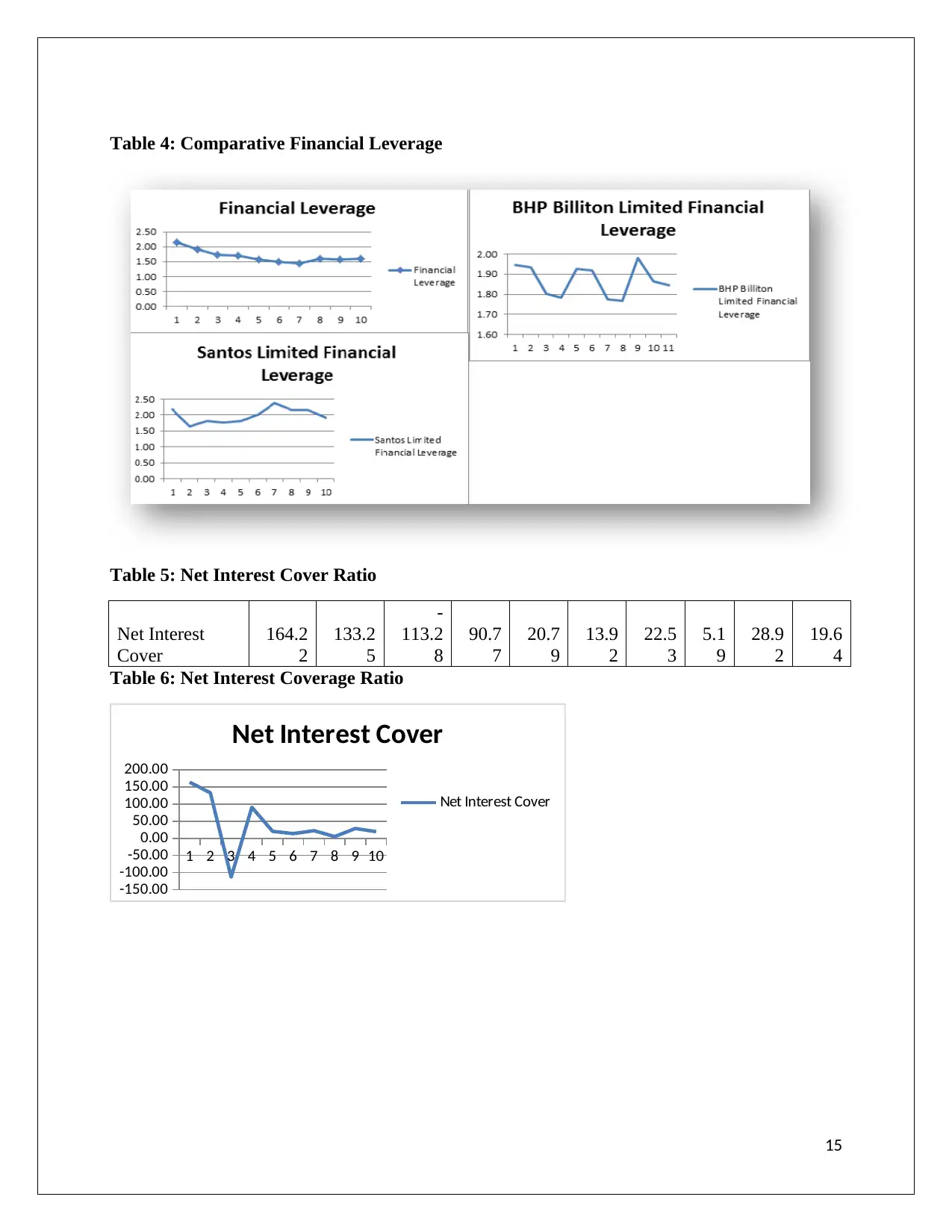
Table 4: Comparative Financial Leverage
Table 5: Net Interest Cover Ratio
Net Interest
Cover
164.2
2
133.2
5
-
113.2
8
90.7
7
20.7
9
13.9
2
22.5
3
5.1
9
28.9
2
19.6
4
Table 6: Net Interest Coverage Ratio
1 2 3 4 5 6 7 8 9 10
-150.00
-100.00
-50.00
0.00
50.00
100.00
150.00
200.00
Net Interest Cover
Net Interest Cover
15
Table 5: Net Interest Cover Ratio
Net Interest
Cover
164.2
2
133.2
5
-
113.2
8
90.7
7
20.7
9
13.9
2
22.5
3
5.1
9
28.9
2
19.6
4
Table 6: Net Interest Coverage Ratio
1 2 3 4 5 6 7 8 9 10
-150.00
-100.00
-50.00
0.00
50.00
100.00
150.00
200.00
Net Interest Cover
Net Interest Cover
15
You're viewing a preview
Unlock full access by subscribing today!
1 out of 15
Related Documents
Your All-in-One AI-Powered Toolkit for Academic Success.
+13062052269
info@desklib.com
Available 24*7 on WhatsApp / Email
![[object Object]](/_next/static/media/star-bottom.7253800d.svg)
Unlock your academic potential
© 2024 | Zucol Services PVT LTD | All rights reserved.





